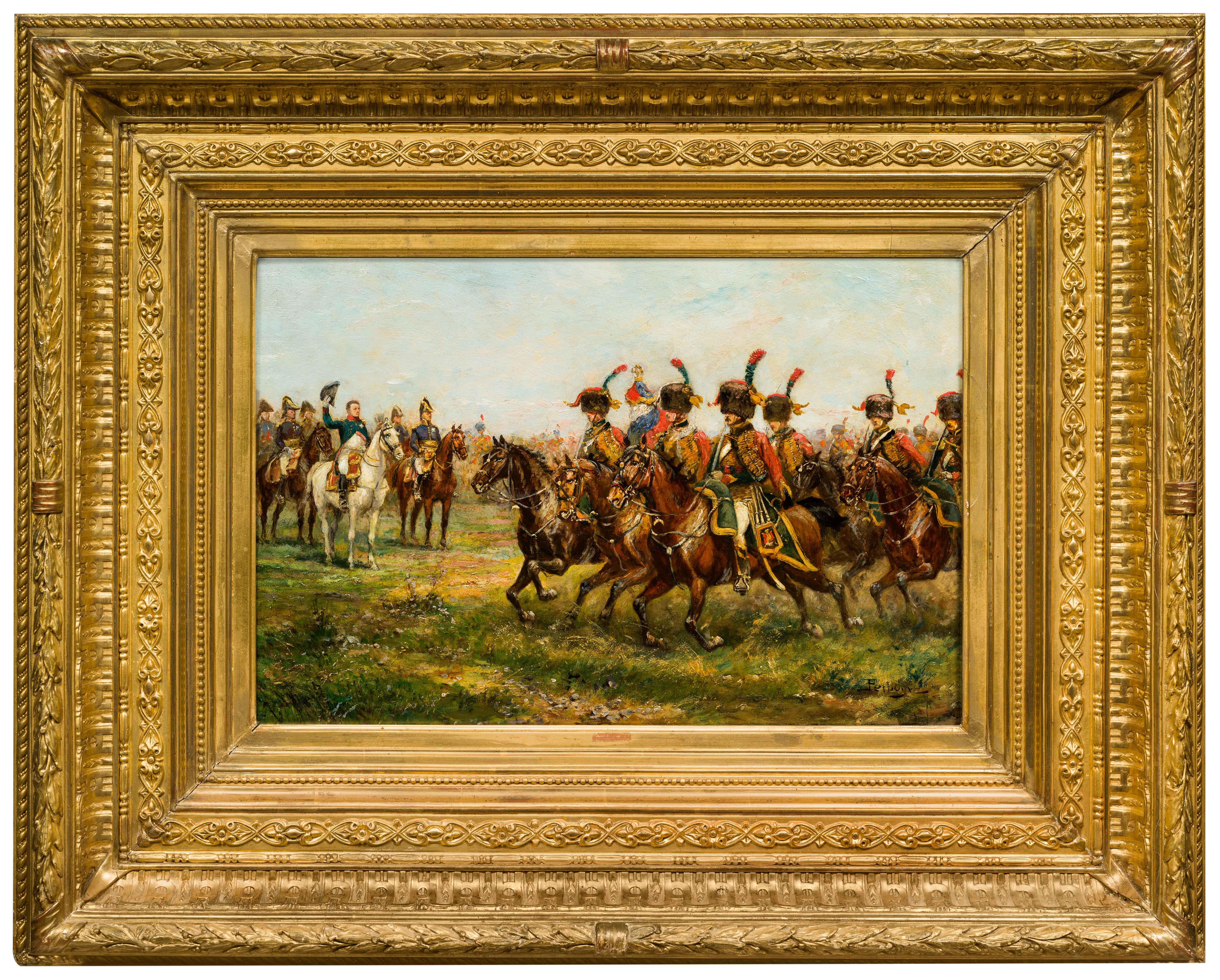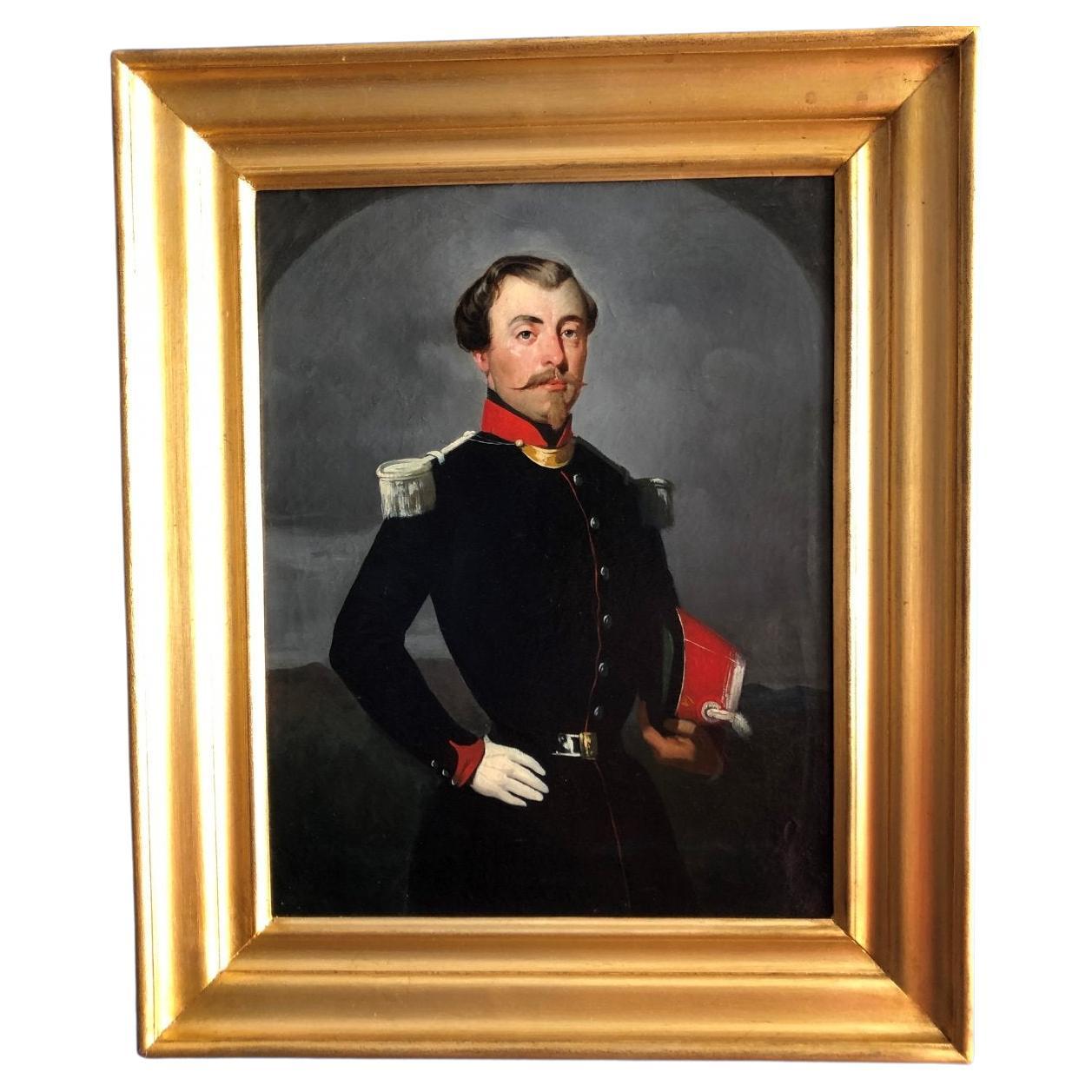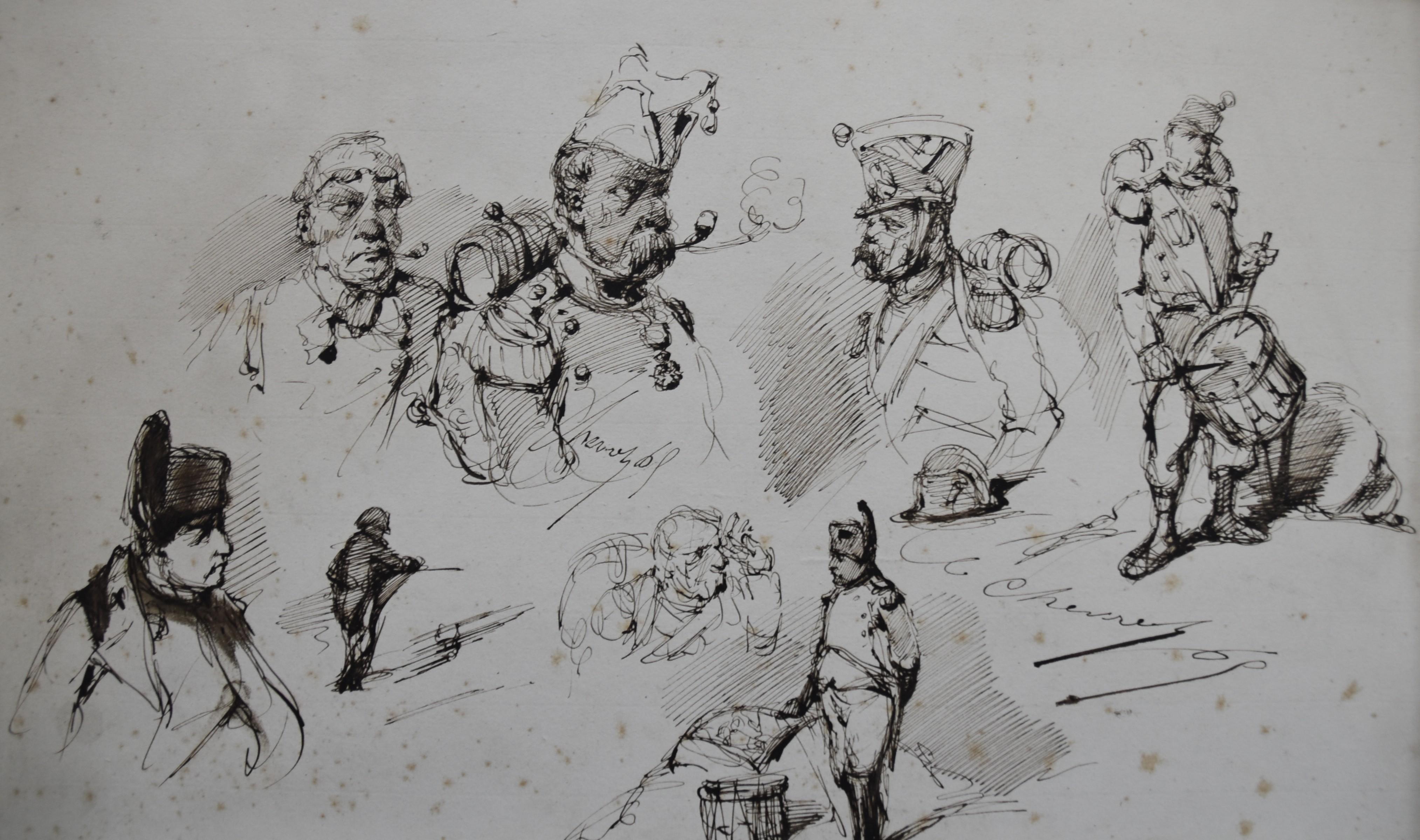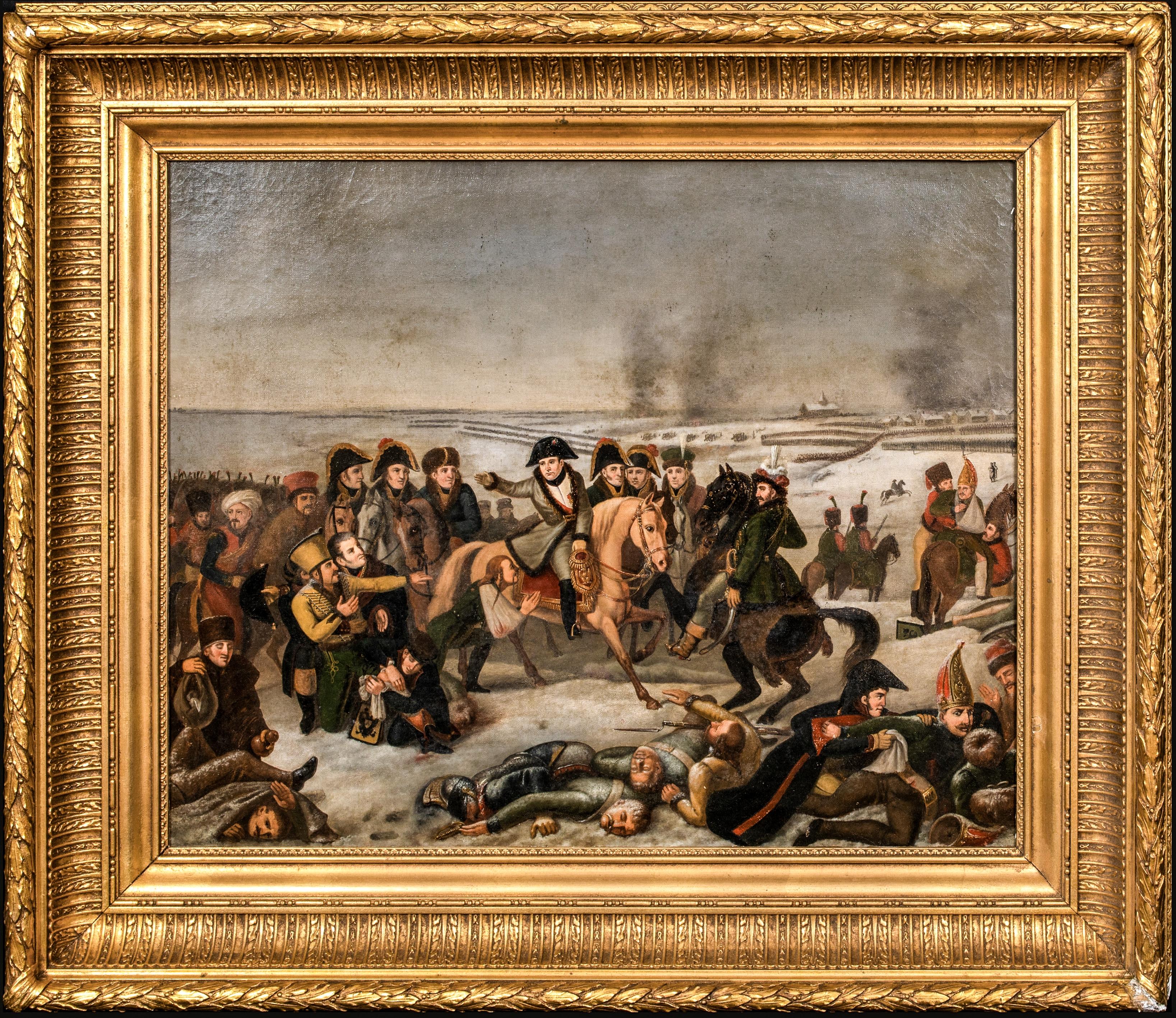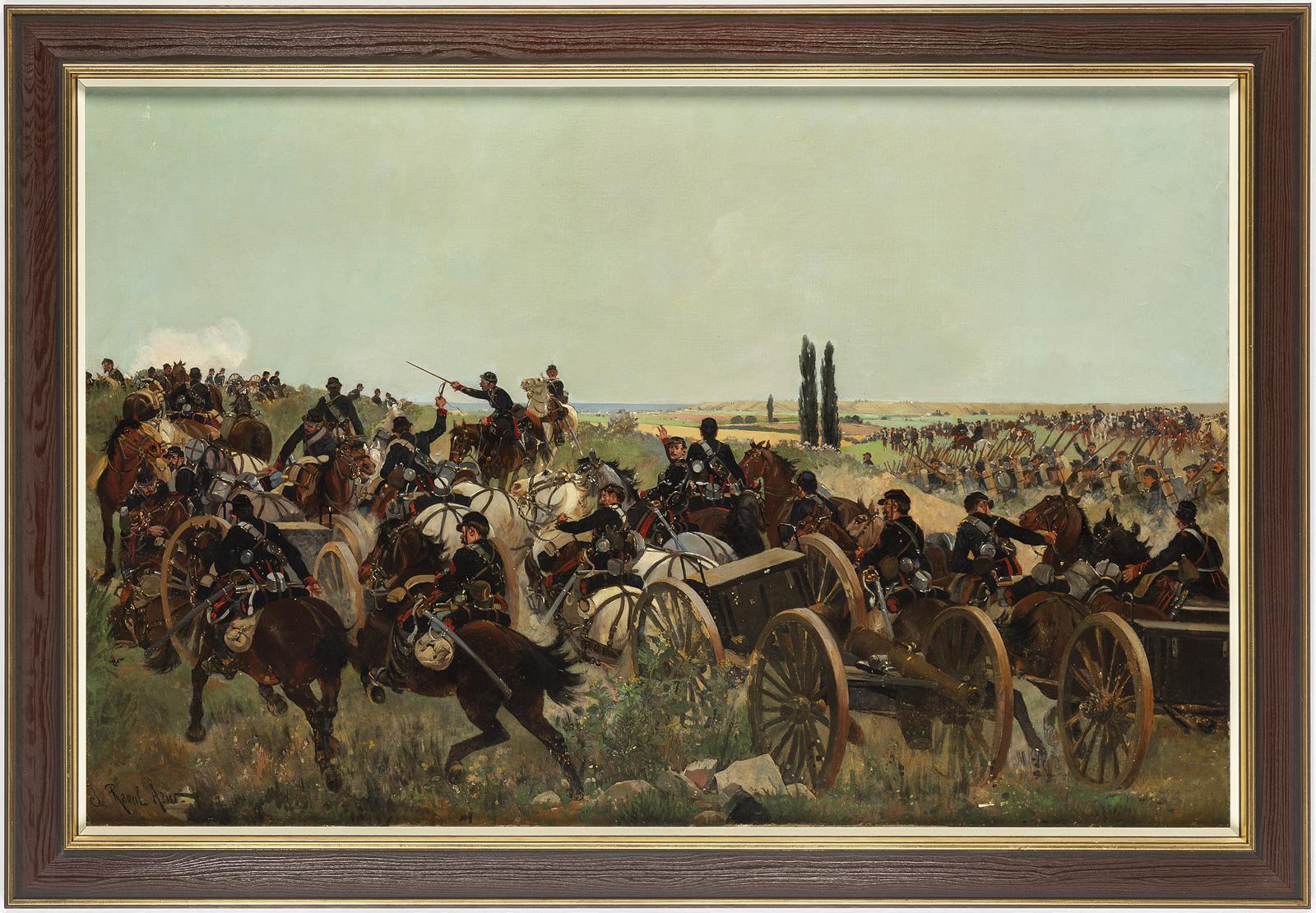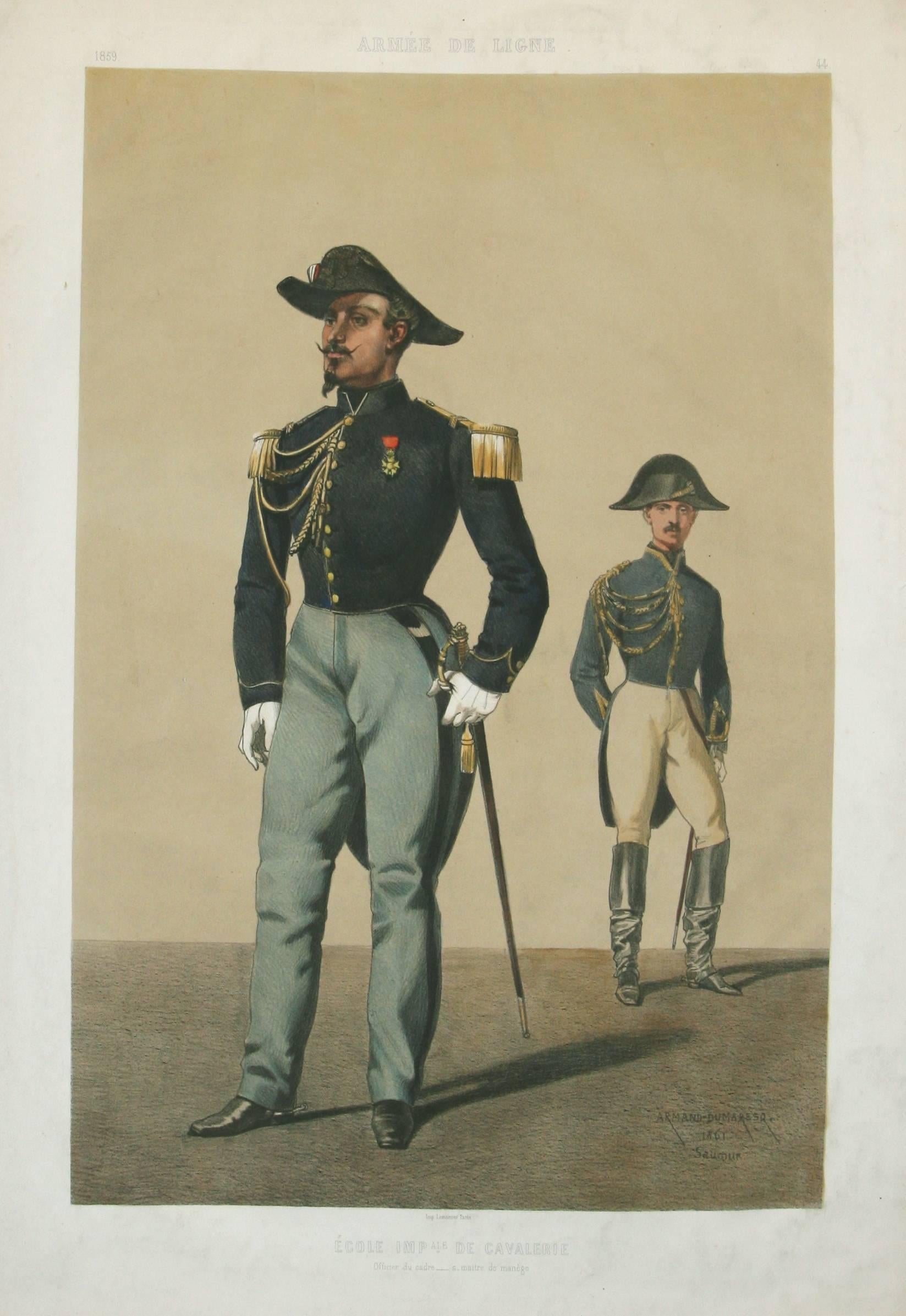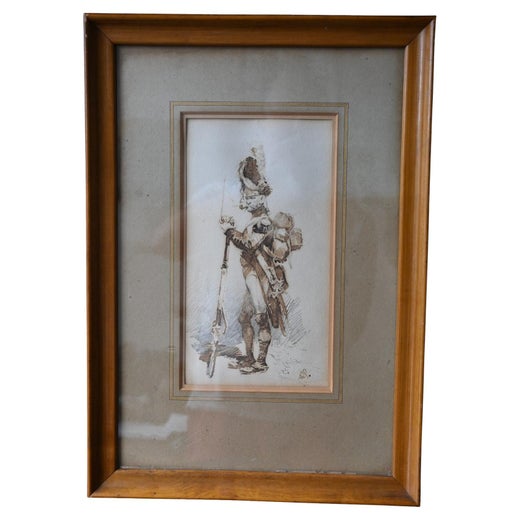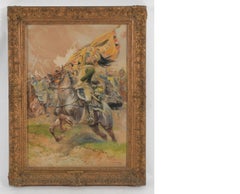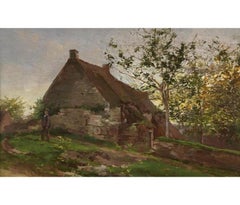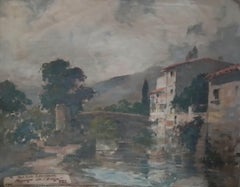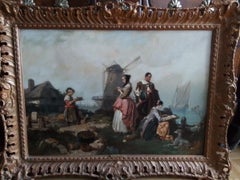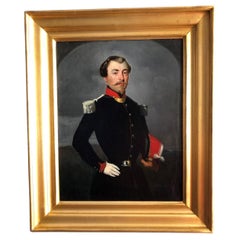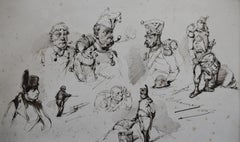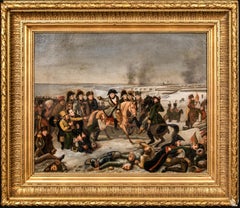Items Similar to Napoleon III-Review by Edouard Detaille - Tempera - signed lower right
Want more images or videos?
Request additional images or videos from the seller
1 of 22
Jean Baptiste Édouard DetailleNapoleon III-Review by Edouard Detaille - Tempera - signed lower right1848-1912
1848-1912
$19,575.23
£14,763.31
€16,800
CA$27,064.46
A$30,316.75
CHF 15,923.45
MX$368,641.89
NOK 201,642.88
SEK 191,413.32
DKK 127,892.59
About the Item
This artwork might be one of two versions, the other one being in the Museum in les Invalides Paris.
Note. This version has a more accomplished academic style.
Dimensions with original gold frame 107 x 87 cm
Conditions Excellent overall, supported by an original frame withan antique glass.
EDOUARD DETAILLE
The emperor is accompanied by his aide-de-camp, Colonel Castelnau, and Marshal Canrobert. In a gilded wooden frame, under a Marie Louise blue background.
Life and time
Born in 1848 into a close-knit bourgeois family, Édouard Detaille, the eldest of eight children, displayed early talent in drawing. “He was a prodigy,” notes François Robichon. By the age of thirteen, he exhibited an astonishing surety of hand and a phenomenal sense of composition. His father, connected to Horace Vernet, encouraged him. At seventeen, after passing his baccalaureate, he entered Meissonier’s studio. This relationship, which developed into mutual affection, spared Detaille the academic detour through the École des Beaux-Arts. Rather than dictating an official art style, Meissonier, at the peak of his fame, traveled with his students, introducing them to the nuances of Titian, Rembrandt, and Rubens in Brussels and Lille.
In 1867, the Paris of “free trade” dominated the world through the technological revolutions of the Universal Exhibition, and the amiable young man, striking in appearance, discovered the salon of Princess Mathilde and the theater of Dumas fils. He even approached the Empress, noting in his journals, “Not bad, the Empress.” This observation encapsulated Detaille: he had no doubts about his talent, cultivated panache, enjoyed the company of beautiful women, and aimed to conquer the circles of power without sacrificing his freedom.
From childhood, he listened to his calling: “Before I could read, I could guess the subjects of battles, the names of famous generals, the weapons of officers and soldiers from the images I admired in the books of Norvins and Laurent de l'Ardèche.” He mingled with collectors and regularly attended military reviews on the Champs-Élysées. His first painting exhibited at the Salon in 1868, “La Halte de tambours,” was praised by critics who immediately recognized “a remarkable truth of observation and simplicity of effect.” The purchase of this work by Princess Mathilde, cousin of Emperor Louis-Napoleon, made Detaille, at twenty, an envied celebrity known to Sainte-Beuve, Théophile Gautier, the Goncourt brothers, and Flaubert. The young artist’s humanistic vision contrasted with the compositions of his predecessors, depicting soldiers in maneuvers, contemplative and resigned as war loomed.
**The Combatant’s Vision**
The Siege of Paris, where he nearly lost his life in 1870, and the deaths of two brothers in that defeat darkened his outlook. From 1871 onward, Detaille no longer concealed the cruelties of war: German riflemen mowed down by machine gun fire, cavalrymen and panicked horses caught in ambushes, fields plowed by shells strewn with dead animals. The unvarnished tragedy: “It is an absolute fact that no painter has ever rendered a battlefield covered with corpses as it is,” commented Jules Claretie. The fallen bodies still bear the appearance of life in their frozen rigidity. Detaille’s testimony of the devastating defeat and the catastrophic effects of the first total war in history was not a celebration of heroism but a lament, a “lesson in darkness.” “From war, once considered the supreme effort of human genius, we now see only melancholy and horrors,” judged one writer in response to his canvases.
“Detaille experienced the reality of combat at a young age during a war that foreshadowed the two world conflicts of the 20th century,” explains François Robichon. With great realism, Detaille painted war from the perspective of the combatant. He introduced a humanity and a critical lucidity regarding the evolution of warfare. His works intensely captured the violence and firepower of new weapons like machine guns. Before he turned thirty, Detaille had become a chronicler of these painful years. He exhibited, as a critic noted, a “striking portrait of modern war” that both French civilians and soldiers had experienced firsthand. He embodied a youth humiliated and eager for revenge. Yet this scrupulous artist also remembered, in his expansive landscapes—from the chalky plateaus of Île-de-France to the Russian plains—the lessons of Corot and Courbet. Manet was not far off. “I wouldn’t want my art to be reduced to mere patriotic art,” he asserted. “A system I often employ and love is to first execute the landscape, very effective, very tight, based on nature…” Echoing Meissonier’s advice: “Always nature, always nature!” Detaille remained close to this father figure, constructing a grand townhouse next to his mentor’s studio at 129 boulevard Malesherbes at the age of 26, having purchased 425 m² of land from the Pereire brothers. He even chose the same architect as Meissonier: Paul Boesvilwald. A bachelor and incorrigible seducer, the painter welcomed his conquests, including Valtesse de la Bigne, amidst his collections, having built his studio in the courtyard.
Diplomatic Actor
As Detaille’s fame grew, his Malesherbes townhouse quickly became a gathering place for foreign princes, politicians, and heads of state, where Juliette Adam, Léon Gambetta’s muse, offered him valuable advice. The Prince of Wales, the future Edward VII, developed a genuine friendship with the painter. “This fervent patriot, friend of Déroulède, was extraordinarily open to the world,” recounts François Robichon. In just a few years, he gained considerable social, cultural, and international stature. Received at Windsor, at the English court, he was close to Tsar Alexander III and a great friend of Félix Faure.
In this capacity, Detaille played a decisive role in the Entente Cordiale, signed in 1904 between England and France, and in the Franco-Russian alliance of 1894, thereby contributing to the Triple Entente among the three powers. An engaged witness of his time—associated with the birth of the “Ligue des Patriotes” alongside Alphonse de Neuville and Déroulède, founder of the “Sabretache,” and initiator of the Army Museum—Detaille was not blinded by his convictions. He was not indifferent to the honors discreetly paid to him by Wilhelm II and the Crown Prince through diplomatic channels. Like Barrès, he placed his hopes in the restoration of a symbol tarnished by Sedan: the French army.
Beyond this choice, he was a man turned towards modernity. “Well-informed from the best sources, he was at the center of European life,” observes François Robichon. Knowledgeable of photography’s potential, he was among the first in the 17th arrondissement to install electricity and telephone, to drive a car, and to attend the Lumière brothers’ cinematograph sessions in 1896. He even contemplated making a historical film. In this sense, he was a precursor. His astonishing war panoramas—Champigny and Rezonville—long sequence shots created with Alphonse de Neuville on rue de Saussure, near the Asnières gate, anticipated the historical cinema of Abel Gance, the naturalism of John Ford, the frescoes of Andrei Tarkovsky, and the emotional power of Apocalypse Now. Did Abel Gance not draw his Napoleonic epic vein from Detaille’s paintings? Detaille imagined a painting beyond the frame, capturing both the entirety and detail of the cathartic upheaval of war. He pushed the traditional boundaries of his profession, paving the way for the major art of the 20th century: cinema.
Detaille passed away on December 24, 1912, at his home on boulevard Malesherbes, and his funeral was nearly a national event, held at Saint-Charles-de-Monceau church on December 27.
SHIPPING: Continental USA and Worldwide delivery included
- Creator:Jean Baptiste Édouard Detaille (1848 - 1912, French)
- Creation Year:1848-1912
- Dimensions:Height: 34.25 in (87 cm)Width: 41.73 in (106 cm)
- More Editions & Sizes:34.25 x 41.73Price: $19,575
- Medium:
- Movement & Style:
- Period:
- Condition:
- Gallery Location:PARIS, FR
- Reference Number:1stDibs: LU2804215381262
Jean Baptiste Édouard Detaille
Jean-Baptiste Édouard Detaille (Paris 5 October 1848 – 23 December 1912 Paris) was a French academic painter and military artist noted for his precision and realistic detail. Detaille grew up in a prosperous military family in Picardy; his grandfather had been an arms supplier for Napoleon. An amateur artist who was friends with a number of collectors and painters, including Horace Vernet, Detaille's father encouraged his son's artistic endeavors. He began his artistic studies at age seventeen under the famous military painter Jean-Louis-Ernest Meissonier; he had originally approached him to ask for an introduction to the renowned Alexandre Cabanel but Meissonier decided to teach Detaille himself. Meissonier became a major influence on his style, and it was he who inculcated an appreciation for accuracy and precision in Detaille.
Detaille made his debut as an artist at the Salon—the official art exhibition of the Académie des Beaux-Arts—of 1867 with a painting of Meissonier's studio. At the Salon of 1868, he exhibited his first military painting, The Drummers Halt, which was based solely on his imagination of the French Revolution. With Repose During the Drill, Camp St Maur, which he debuted the following year, Detaille established his reputation as a painter. In the spring of 1870, he went on a "sketching trip" to Algeria with three other young painters, Étienne-Prosper Berne-Bellecour, Alexander Louis Leloir, and Jehan Georges Vibert.
Detaille enlisted in the 8th Mobile Bataillon of the French Army when the Franco-Prussian War broke out in 1870; by November he was seeing and experiencing the realities of war. This experience allowed him to produce his famed portraits of soldiers and historically accurate depictions of military manoeuvres, uniforms, and military life in general. He eventually became the official painter of the battles. He published a book called L'Armée Française in 1885, which contains over 300 line drawings and 20 color reproductions of his works. Detaille was one of the first artists to buy photographs from Eugène Atget.
In 1912, Detaille created new uniforms for the French army. They were never adopted by the Minister of War, but the blue-gray greatcoats would influence later French World War I uniforms, and the Adrian helmet was heavily influenced by his designs.
During his life, he had amassed an impressive collection of military uniforms and artifacts and bequeathed to the Musée de l'Armée in Paris following his death.
Detaille appears as a guest at a party at the home of the Princesse de Guermantes in Part Two: Chapter One of Marcel Proust's novel, Cities of the Plain, where Detaille is referred to as "the creator of the Dream", his 1888 painting also known as Le Rêve (The dream) which shows soldiers asleep on a battlefield dreaming of military glory. The painting, which is located at the Musée d'Orsay in Paris.
About the Seller
5.0
Gold Seller
Premium sellers maintaining a 4.3+ rating and 24-hour response times
Established in 2024
1stDibs seller since 2024
10 sales on 1stDibs
Typical response time: <1 hour
- ShippingRetrieving quote...Shipping from: PARIS, France
- Return Policy
Authenticity Guarantee
In the unlikely event there’s an issue with an item’s authenticity, contact us within 1 year for a full refund. DetailsMoney-Back Guarantee
If your item is not as described, is damaged in transit, or does not arrive, contact us within 7 days for a full refund. Details24-Hour Cancellation
You have a 24-hour grace period in which to reconsider your purchase, with no questions asked.Vetted Professional Sellers
Our world-class sellers must adhere to strict standards for service and quality, maintaining the integrity of our listings.Price-Match Guarantee
If you find that a seller listed the same item for a lower price elsewhere, we’ll match it.Trusted Global Delivery
Our best-in-class carrier network provides specialized shipping options worldwide, including custom delivery.More From This Seller
View AllCavalry Charge 1st Empire - Edouard Detaille - French art
By Jean Baptiste Édouard Detaille
Located in PARIS, FR
Conditions : Very good original Conditions including a beautiful frame. Framed under glass, this rare composition for sale is an exceptionnel piece for Art collectors.
Signed and d...
Category
Late 19th Century Academic Landscape Paintings
Materials
Tempera
Vintage art painting by Camille Delpy - Normandy house
By Hippolyte Camille Delpy
Located in PARIS, FR
Conditions : Excellent overall Conditions.
Free US CONTINENTAL shipping, incl Europe and Asia.
Hippolyte Camille Delpy, born April 16, 1842 in Joigny (Yonne) and died June 5, 1910 i...
Category
19th Century Barbizon School Landscape Paintings
Materials
Oil
Vintage french art painting by Paul emile Lecomte - oil on canvas, signed
By Paul Emile Lecomte
Located in PARIS, FR
Old exhibition label. Free US CONTINENTAL Shipping, incl Europe and Asia.
Provenance: Artist's family, atelier sale. Excellent condition under UV light with no prior restoration. T...
Category
Late 19th Century Impressionist Landscape Paintings
Materials
Oil
Eugène Lepoittevin. A drawing lesson by the Sea - oil on canvas - signed 1853
Located in PARIS, FR
Conditions : Good overall Conditions with minor retouching under UV light (as seen on pictures). Slight invisible crack in the canvas. Original Victorian frame in excellent conditio...
Category
Mid-19th Century Realist Landscape Paintings
Materials
Oil
Victorian vintage art by Dibdin, watercolor tempera - 1863
Located in PARIS, FR
Excellent condition. Mint.
Free US CONTINENTAL shipping, incl Europe and Asia.
Thomas Colman Dibdin was an illustrator and painter. Born at Bletchworth, Surrey, on 22 October 1810,...
Category
Late 19th Century Impressionist Landscape Paintings
Materials
Watercolor, Gouache, Carbon Pencil
French art painting by Alfred Smith - Bordeaux, a Tramway, collector piece.
Located in PARIS, FR
Conditions : Minor retouching on the upper part, original canvas with frame.
Currently Under Restoration by Museum specialist for Alfred Smith paintings....
Category
Late 19th Century Impressionist Landscape Paintings
Materials
Oil
You May Also Like
Les Chasseurs de la Garde Impériale saluent l'Empereur Napoléon 1er et son Etat
By Paul Emile Léon Perboyre
Located in Paris, FR
Paul Emile Perboyre
1826-1914 French
Le Marechal Ney passant ses Troupes en Revue (The Marshall Ney reviewing his Troops)
Oil on mahogany panel
Signed l...
Category
19th Century Figurative Paintings
Materials
Oil, Panel
Painting on Canvas of a French Officer, Napoleon III Period
Located in Saint-Ouen, FR
Painting on canvas of a French officer, Napoleon III period
Very nice oil on canvas of the 19th century, Napoleon III period, Military Officer.
Dimensions:
Painting: H: 41cm...
Category
Antique 19th Century European Napoleon III Paintings
Materials
Canvas
Edouard Chevret (1835-1874), Napoleon and his soldiers, Studies, 1860, drawing
By Edouard Chevret
Located in Paris, FR
Edouard Chevret (1835-1864)
Napoleon and his soldiers, different studies
Signed on the lower right and dated 1860
28 x 45 cm
In a modern mount covering the original mount.
In quite g...
Category
1860s Portrait Drawings and Watercolors
Materials
Ink
Napoleons Retreat From Russia, 19th Century French School Large Napoleonic Wars
Located in Blackwater, GB
Napoleons Retreat From Russia, 19th Century
French School Large Napoleonic Wars Scene
Large 19th Century French School Napoleonic Wars Scene of Napoleon retreating following the in...
Category
19th Century Portrait Paintings
Materials
Canvas, Oil
$3,955 Sale Price
35% Off
The French-Prussian War - Oil on Canvas by Raoul Arus - Late 19th Century
Located in Roma, IT
The French-Prussian War is an original modern artwork realized by the French painter Raoul-Joseph Arus in the last decades of the XIX Century.
Original Oil painting on Canvas.
Hand...
Category
Late 19th Century Figurative Paintings
Materials
Canvas, Oil
Ecole Imp.DE Cavalerie, Officier du Cadre Armee De Ligne pub. Lemercier 1861
By Édouard Armand-Dumaresq
Located in Paonia, CO
Ecole Imp.DE Cavalerie, Officier du Cadre shows two bearded French soldiers from the Armee De Ligne or the Line Army series. There is an officer in the foreground and a soldier...
Category
1860s Figurative Prints
Materials
Lithograph
